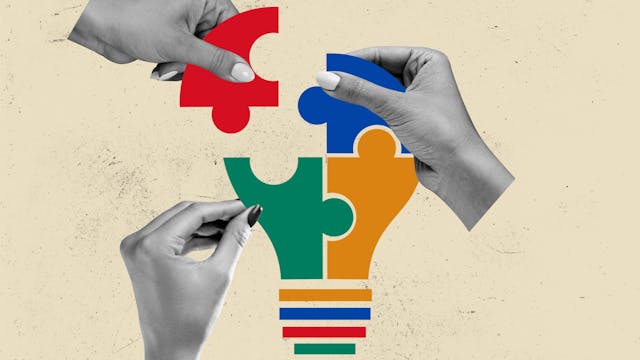What will it take to build a sustainable early care and education system in the United States?
That was the question I posed to leaders from the field who came together on March 8 — coincidentally, International Women's Day — to weigh in on the issue, sharing solutions they're seeing that seem promising, innovative and scalable. The setting for our conversation was a featured panel at the SXSW EDU Conference and Festival in Austin, Texas.
The most obvious answer is federal investment and lots of it — far more than is available in the U.S. today.
Significant federal investment that values the first five years of life as much as the next 13 would go a long way toward solving the crisis that exists in the early care and education sector today. But after a close call last year, when child care relief — at one point central to President Biden’s signature legislation — was removed altogether ahead of the passage of the Inflation Reduction Act, the window of opportunity to address this issue in the legislative branch has effectively closed. With split chambers in Congress, this avenue is no longer politically feasible, and it may not be for some time.
So, what is possible? In the absence of public investment and system-wide change, what are the next-best options — the viable alternatives?
The full discussion is available to watch below. For audio only, listen here.
Michelle Kang, CEO of the National Association for the Education of Young Children, noted that employer-sponsored child care has been getting “renewed focus” since the pandemic began and, most especially, in recent weeks.
In August, Biden signed the CHIPS and Science Act, which invests in research and manufacturing of semiconductors in the U.S. Then in late February, the Commerce Department announced that, for semiconductor companies to access these federal funds, they’ll need to make high-quality, affordable child care available to all employees.
Many see this move as the Biden administration’s way of keeping child care in the conversation, despite a reshuffling of the politics in Washington and the outcome of last year’s legislative negotiations. Still, some view it as wrongheaded, arguing that child care “should never be a job-linked benefit.”
The idea of employers getting involved in child care, or offering child care as a benefit to employees, is not new. Kang herself spent many years at Bright Horizons, one of the nation’s largest providers of employer-sponsored care. But the concept has gained traction as employers look for ways to fill open positions in a tight labor market and retain their existing workers.
“It is not a perfect solution,” Kang said, “but it is a solution.”
The arrangement can extend well beyond on-site and near-site child care options, Kang noted. Employers can partner with existing providers in the community, pay funds directly to providers to increase educator wages, and help subsidize the cost of employees’ child care.
“Employers should have skin in the game,” added Mia Pritts, vice president of strategic partnerships at Wonderschool, a company that helps to improve the supply and quality of child care options. “They have a need to be met so they can hire people to show up and do their best work, whether that’s a shift worker or a judge. This is one of the places where I think there’s an opportunity to think really differently and really creatively.”

Pritts also highlighted a program in Nevada, in which the state’s welfare and social services department is partnering with a social impact investment organization to buy 40 houses that are licensable for in-home group child care. The goal is to become “a child care-friendly landlord,” which is important, especially in Nevada, where landlords and homeowner associations — not tenants — have all the rights when it comes to renting properties.
“That’s a really promising pilot for public-private partnerships, breaking through barriers in housing while we wait for the policy to catch up on the other side of things,” Pritts said.
Natalie Renew, the director of Home Grown, a national initiative that works with home-based child care providers around the country, highlighted an innovation from the guaranteed income sector.
Called the Thriving Providers Project, the program seeks to address provider and educator compensation with “ongoing, predictable and unconditional direct cash to home-based child care providers, with the theory and a belief that when providers are financially and economically secure, their willingness to engage in training, their ability to be emotionally available and responsive caregivers, improves,” Renew said.
The program is underway in Colorado and is in development in a number of large cities and states throughout the U.S.
Renew noted that direct cash payments work well for providers, adding: “We also saw it works really well for parents, with the Child Tax Credit,” which lifted millions of children out of poverty for the short period that it was available in the U.S.
Guaranteed income is sustainable and scalable, Renew explained, because it is administratively lean, fairly easy to do and can be implemented equitably. She noted that hundreds of pilots are in place around the country, and that city and state leaders have shown great interest, in part because of how successful the Child Tax Credit was.
“There's just a lot of promise here, and I think it's a way to really put families and providers in the driver's seat around what the system can and should look like,” Renew said.
During the discussion, Kang, Pritts and Renew all returned to the idea that early care and education is interconnected with nearly everything else: school readiness, workforce participation, strong communities, lifelong success and more. It’s why they believe the crisis in early childhood should be a national concern, not just an individual responsibility.
“Covid has really shined a light on the cracks in the system — or the crevasses, as they may be — but we also know that where there are cracks, that’s where the light can get in,” said Pritts. “We need to really make sure not to lose sight of this opportunity, because it matters for all of us. No matter what stage of life we’re in, no matter where or how we work, this impacts all of us.”


